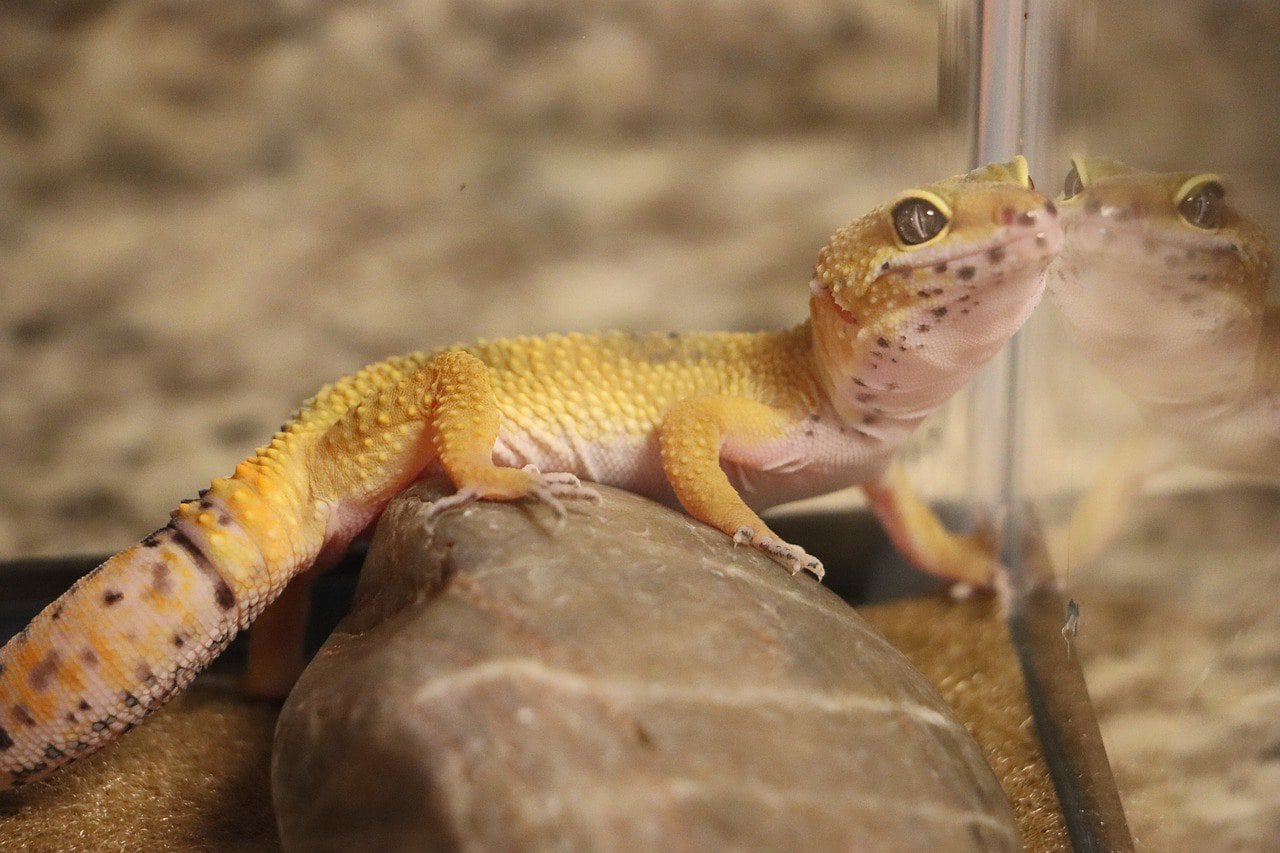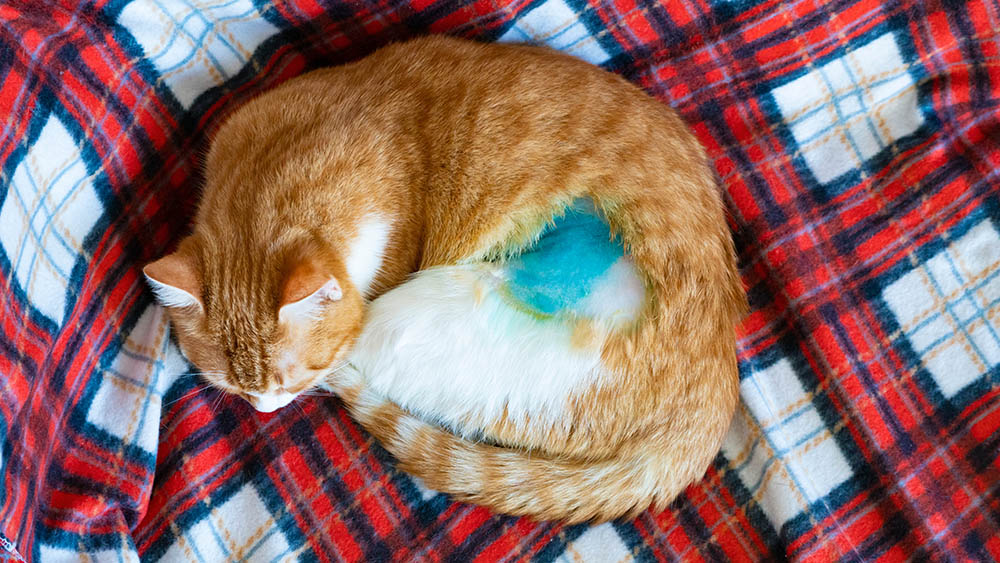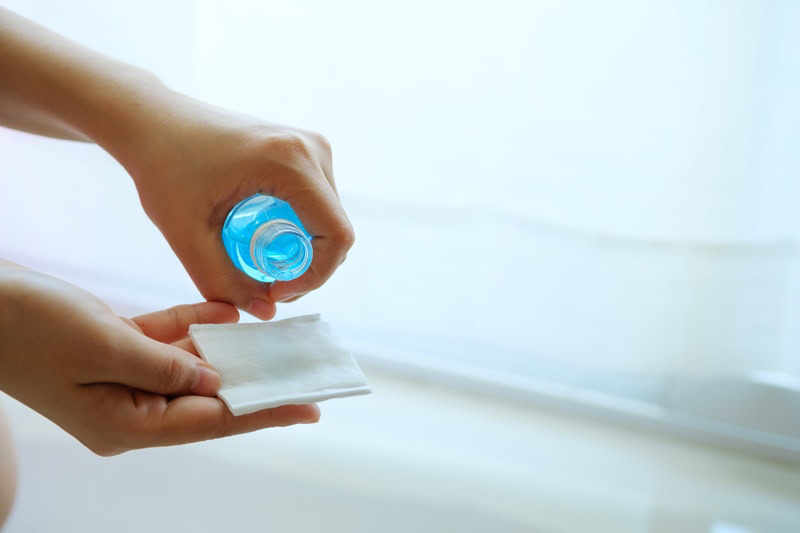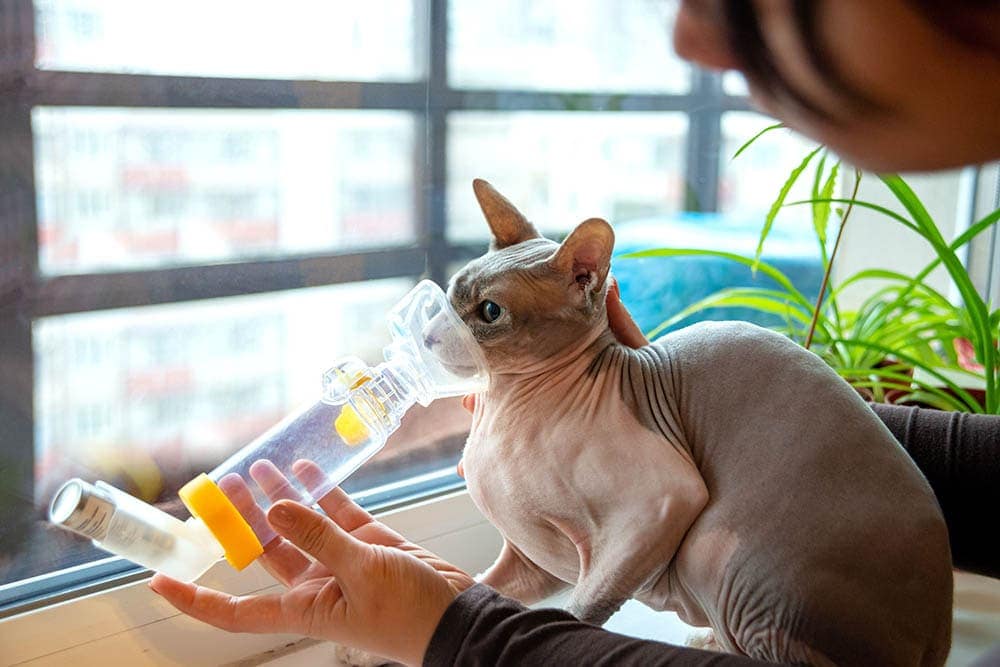VET APPROVED

The information is current and up-to-date in accordance with the latest veterinarian research.
Learn more »Many wild and domestic animals will swim to cool down, for fun, or to hunt for their next meal. Others prefer to keep their feet on dry land. Leopard Geckos (Eublepharis macularius) will sit in shallow water to soften their skin for shedding or to cool down, but they can’t swim well and don’t like being around too much water.
Since a water dish is often a recommended part of a gecko’s vivarium, it’s important to choose the right one to suit your pet’s needs. This guide will tell you why leopard geckos are poor at swimming and why they still need a source of water, even if they don’t want to splash around in it.

Can Leopard Geckos Swim?
Unlike their feline namesake, leopard geckos are not fond of swimming. They can waddle for a short time and will definitely try to stay afloat, but they will tire out quickly and try to get out of the water as soon as possible. If they don’t find an escape route out of the water quickly, they will almost certainly drown.
There are several reasons as to why leopard geckos are such poor swimmers.
Tail Hindrance
From an anatomical perspective, leopard geckos are not adept at swimming largely due to their tail. Though some geckos, like the flat-tailed house gecko (Hemidactylus platyurus) have a tail that helps them quickly “run” over bodies of water 1, a leopard gecko’s tail doesn’t help them when it comes to swimming. In fact, it works against them.
A leopard gecko’s tail serves the primary function of a fat deposit chamber of sorts. This makes it quite heavy; a leopard gecko’s tail accounts for nearly a quarter of their total body weight. What’s even more interesting is that, unlike most lizards, leopard geckos don’t simply drag their tail around wherever they go.
During normal locomotion (movement), leopard geckos lift their tail off the ground. Their tail plays a role in pelvic rotation and the length of their strides as they walk. Their tail undulates (swings side to side) as they move, in coordination with their limbs 2.
Having such a heavy tail is a detriment to swimming because the mass of their tails is very inefficient when they have to move quickly (which is required for swimming). Moving their tail in coordination with their limbs while swimming would require a tremendous amount of force and power.
In essence, their bodies would have a reduced amount of time available for swinging the tail from side to side (in conjunction with the limbs)—a shortfall of time that can only be compensated by generating enough force from their muscles.
Given the mass of their tail in relation to the rest of their body, swimming might simply not be possible for leopard geckos. They would quickly tire out if forced to swim and possibly drown if they can’t access land rapidly.
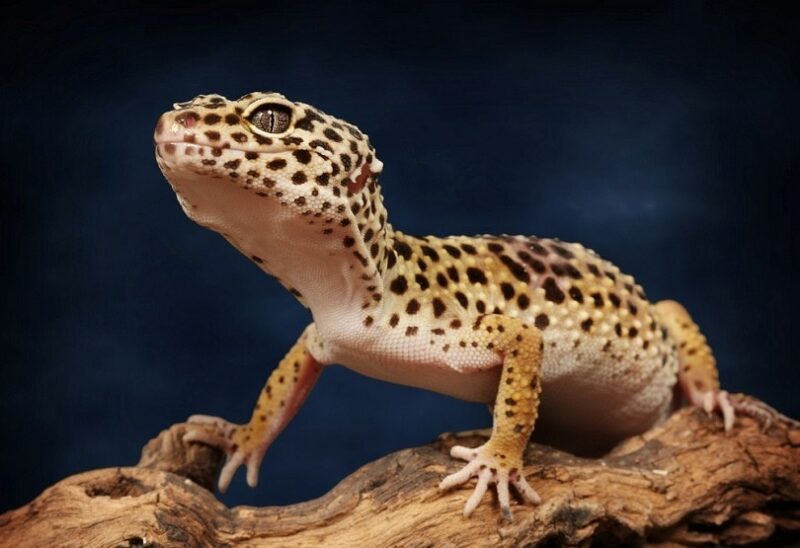
Gait Change Due to Tail Loss
We’ve established that having a huge tail is a hindrance when it comes to swimming, but what about leopard geckos that lose their tail? This is an important defense mechanism and a secondary role their tails serve. Would the loss of a heavy tail make swimming easier?
Not quite! Due to such a sudden shift in their mass when their tail is lost, leopard geckos shift their center of gravity more forward, scrawl lower, and take narrower strides. All three of these adaptations make it extremely difficult to swim!
Evolutionary Adaptation
Leopard geckos’ swimming problems might also be due to their evolution. These lizards live in arid grasslands and deserts, where bodies of water they’d have to swim across are a very rare occurrence. These are also places where temperatures can drop drastically low in the winter – below 50oF (10oC), which forces them into brumation (a hibernation-like state). As they brumate, they rely on their fat reserves (within their tail) for sustenance.
Therefore, it seems that leopard geckos have evolved to not need to swim at all and have reconfigured their anatomy to help them survive the seasonal shifts.
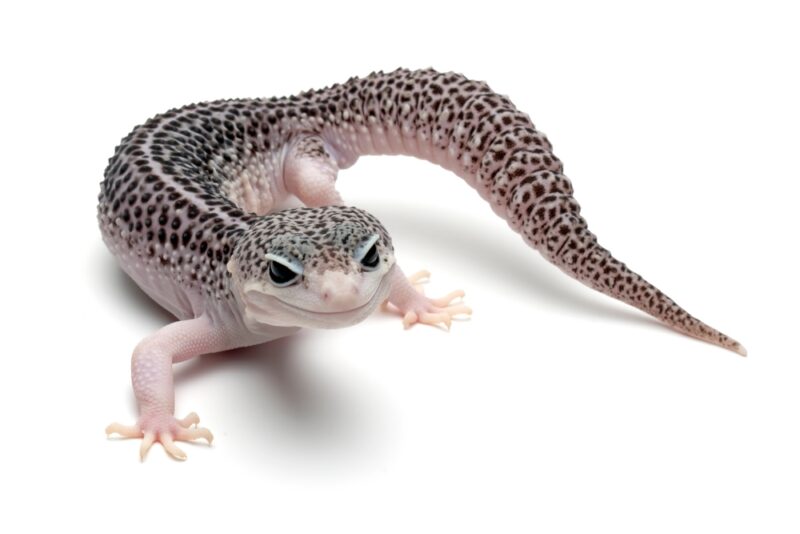

Should You Let Your Leopard Gecko Swim?
Swimming might sound like a good way for your leopard gecko to pass the time, but their inability to swim makes it incredibly dangerous. Although they can momentarily float, their body isn’t designed to keep them above the surface for long.
It’s safer and far healthier for your leopard gecko if you don’t try to encourage them to swim. You can leave a water dish in their vivarium so they can sit in it, but make sure it is shallow enough so they don’t have to swim in it to get out. The water in their dish should not exceed the level of their shoulders.
If you want your leopard gecko to have enrichment activities in their vivarium, you should find safe options, such as rocks and plants for hiding and live crickets for chasing.

How to Give Water to Your Leopard Gecko
Leopard geckos are native to arid climates and don’t need as much water as other pets. However, providing clean water is still an important part of their care, both to manage their vivarium’s humidity level and for them to drink. There are several ways that you can give water to your leopard gecko.
Misting
When it comes to taking care of reptiles, misting them and their environment helps keep the vivarium humid and moist. It’s more time consuming than using a bowl of water, but you’ll be able to better monitor the humidity levels in their habitat.
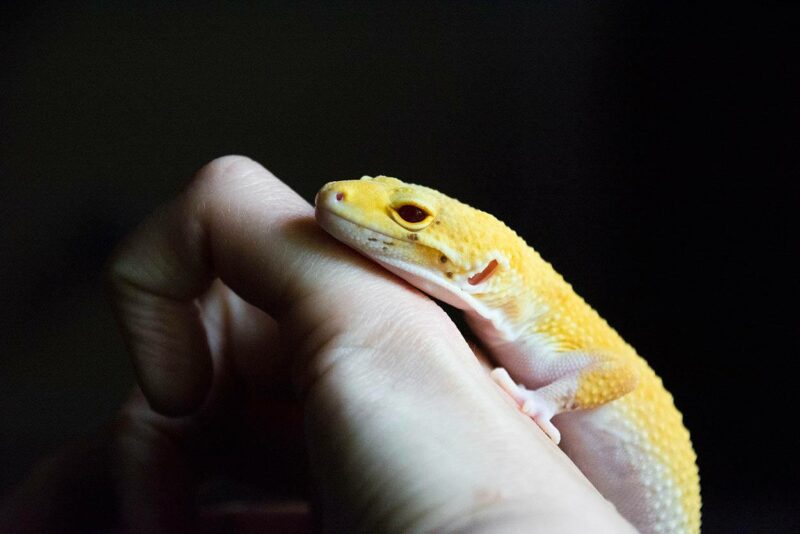
Shallow Bowl
Despite their inability to swim, leopard geckos do like to sit in shallow water. For this reason, you should use a shallow bowl to keep your water in. This serves two purposes. One, it enables your leopard geckos to soak their entire body whenever they need to—particularly when they’re shedding—and two, it can help manage the humidity level in their vivarium. It’s important to make sure the bowl is big enough to hold your gecko but is not so deep that they risk drowning.
You must change the water frequently to ensure that your pet always has clean, fresh water nearby. The water should be changed at least once a day. It’s best to keep the water dish on the cool side of the vivarium.
Humidity Hides
Geckos are prey animals and will need places to hide throughout their vivarium. These areas help them feel safe, and one can serve as a cool, damp place. Your leopard gecko will visit this humidity hide to relax and take advantage of the moist air when they’re shedding.
You can purchase a humidity hide from a pet store or use an overturned container that’s big enough for your pet. To ensure that it’s humid enough, you may need to line it with damp sphagnum moss or paper towels.
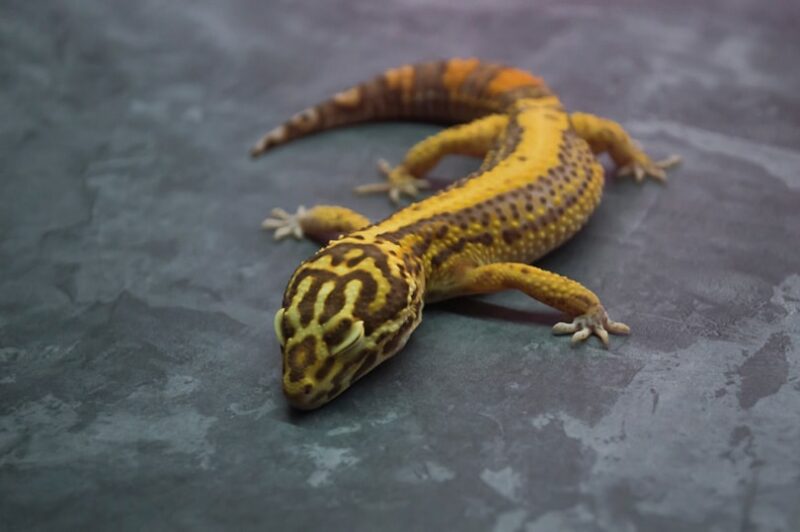

Why Is My Leopard Gecko Sitting in Their Water Dish?
Leopard geckos might not be able to swim, but you’ll often see them sitting in their water dish. This is why the bowl needs to be shallow enough to prevent drowning but big enough that they can sit in it as much as they want. Your pet gecko will sit in their water dish for several reasons.
Drinking
Despite being used to dry environments, water is still a necessity for their survival, and they will drink when they need to. Most of your leopard gecko’s hydration will come from the insects they eat.
If they have a moisture-rich diet, you likely won’t see your leopard geckos drinking much, but it’s still a good idea to keep fresh water in their vivarium at all times. Every so often, you might see them sitting in the water whenever they want a drink.
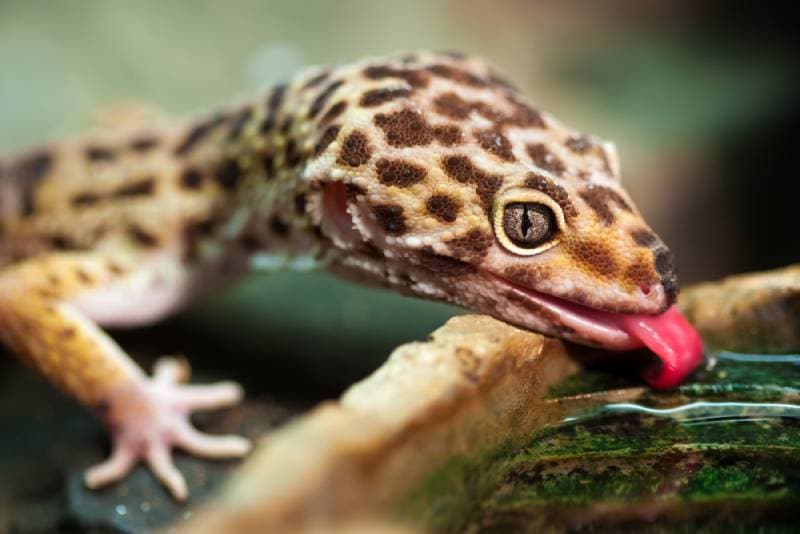
Regulating Moisture
Leopard geckos are cold-blooded and, therefore, rely on their environment to regulate their body temperature. You can help them by keeping the vivarium at the perfect temperature and humidity level, so your pet can dart from their cool spot to their basking area and back again whenever they need to.
Having a dish of water is another way for them to regulate their body’s needs. It will help hydrate their skin when it gets too dry during their basking and cool them down if they get too hot.
Shedding
A natural part of your leopard gecko’s routine is shedding their skin. This process is much easier when their environment is humid. A humidity hide can help, and your gecko will likely spend a great deal of time in there when they’re shedding to soften their skin and make it easier to remove.
Sitting in their water dish has a similar effect. It enables them to soften their skin and makes it easier to remove the shed layers.

Conclusion
Although leopard geckos share a name with one of the best swimmers in the cat world, they don’t share the same swimming ability. In fact, they can’t swim well at all and much prefer staying on dry land.
However, leopard geckos will sit in shallow water or a humidity hide if they need to moisten their skin while they’re shedding. They should have a water dish that’s big enough to suit their needs but not deep enough that they can’t touch the floor to reduce the risk of drowning.
- https://www.medvetforpets.com/leopard-gecko-information-care-sheet/
- https://www.meams.vet/wp-content/uploads/2018/12/Leopard-Gecko-Care-Sheet-MEAMS.pdf
- https://www.rspca.org.uk/adviceandwelfare/pets/other/leopardgecko
- https://www.rspca.org.uk/documents/1494939/0/Leopard+Gecko+Care+Sheet+(PDF+379KB).pdf/14188c25-57f7-feab-d801-a9dfddc7cb93?t=1556101270505
- https://www.ncbi.nlm.nih.gov/pmc/articles/PMC5589804/
- https://www.cell.com/current-biology/fulltext/S0960-9822(18)31469-6?_returnURL=https%3A%2F%2Flinkinghub.elsevier.com%2Fretrieve%2Fpii%2FS0960982218314696%3Fshowall%3Dtrue
- https://www.ncbi.nlm.nih.gov/pmc/articles/PMC10044651/
Featured Image Credit: Leroy Dickson, Pixabay
